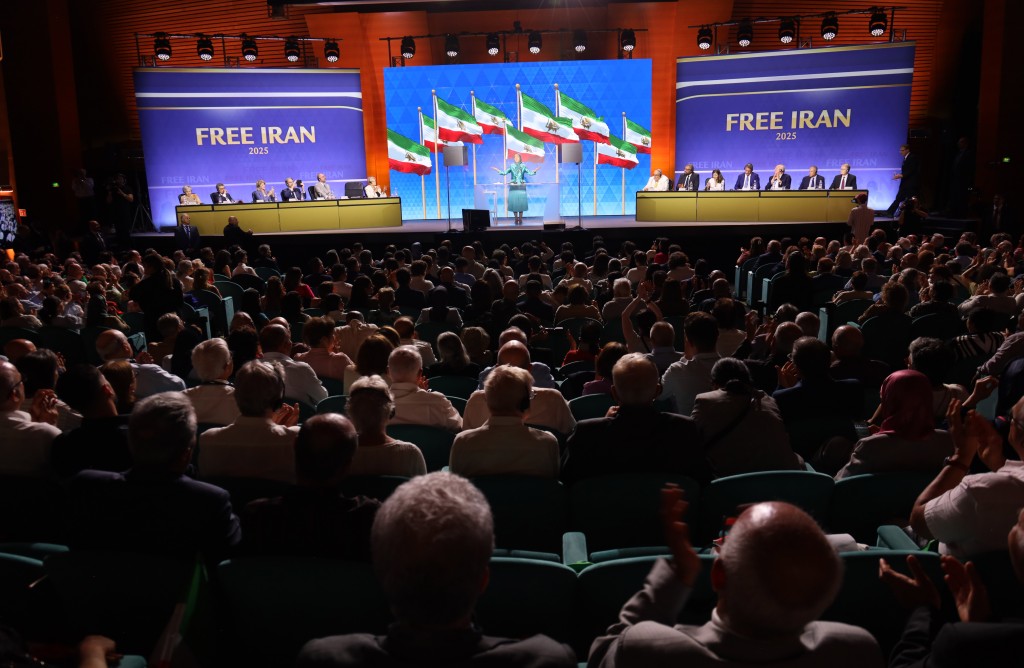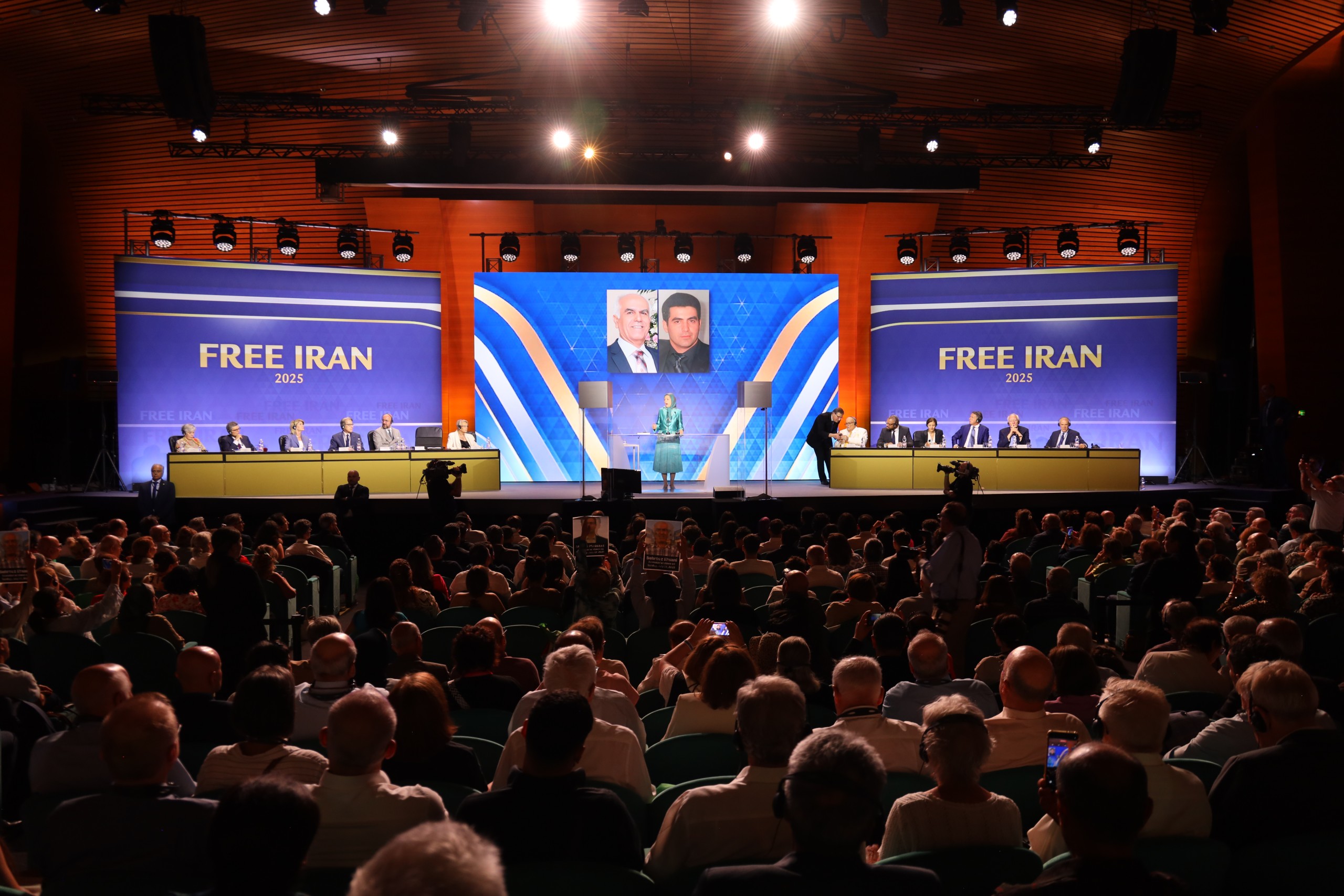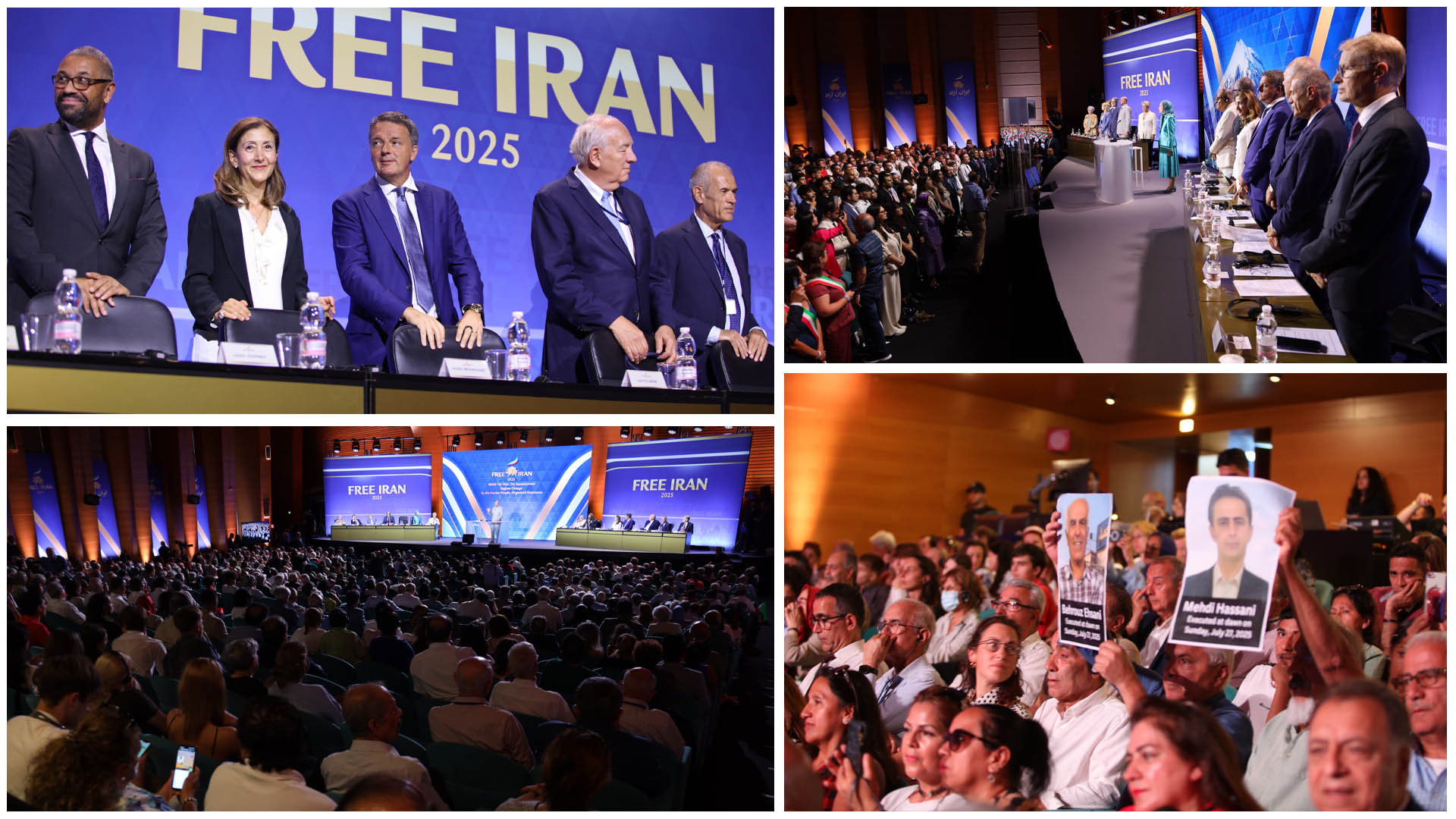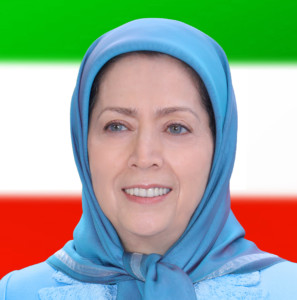Maryam Rajavi’s Vision: Building a Free and Democratic Iran

Speech by Maryam Rajavi at the Free Iran World Summit 2025 – Italy
The Free Iran World Summit 2025 was held on Thursday, July 31, in Rome, Italy, with the participation of a number of Italian parliamentarians and senators, alongside prominent international political figures and freedom-loving Iranians.
Among the prominent figures attending the summit were:
•Charles Michel, former President of the European Council (until 2024)
•James Cleverly, UK Foreign Secretary (2022–2023)
•Matteo Renzi, Prime Minister of Italy (2014–2016)
•Mayor Rudy Giuliani, former Mayor of New York City
•Ambassador Hans-Ulrich Seidt, former German Ambassador to Afghanistan and North Korea
•Michèle Alliot-Marie, former French Foreign Minister and senior cabinet minister (2010–2011)
•Senator Giulio Terzi, Chair of the European Union Policies Committee in the Italian Senate
•Senator Lucio Malan, leader of the Brothers of Italy party in the Senate
•Carlo Cottarelli, former Prime Minister-designate of Italy and former IMF Director of Fiscal Affairs
•Ambassador Stephen J. Rapp, U.S. Ambassador-at-Large for Global Criminal Justice (2009–2015)
•Ambassador Carla Sands, former U.S. Ambassador to Denmark, Greenland, and the Faroe Islands (2017–2021)
•Linda Chavez, former Director of Public Liaison at the White House
•Íngrid Betancourt, former Colombian presidential candidate
•Senator Marco Scurria, Deputy Leader of the Brothers of Italy group in the Senate
•Naike Gruppioni, Member of the Italian Parliament and Foreign Affairs Committee
•Emanuele Pozzolo, Member of the Italian Parliament
The summit also featured speeches by representatives of Iranian youth and professionals living in Italy.
Prior to the main event, Maryam Rajavi and several distinguished guests visited an exhibition held in memory of two fallen members of the People’s Mojahedin Organization of Iran (PMOI/MEK), Behrouz Ehsani and Mehdi Hassani, as well as in commemoration of the anniversary of Operation Eternal Light and the 1988 massacre of political prisoners in Iran. They paid tribute to the martyrs and honored their sacrifice.
Opening the summit, Maryam Rajavi addressed the people of Iran with the following message:
Dear Compatriots,
Distinguished Friends of the Iranian Resistance,
We hold this summit as the religious dictatorship, through the execution of heroic PMOI members Behrouz Ehsani and Mehdi Hassani, is laying bare its desperation in the face of the people and the organized resistance. These were heroes, who never bowed, and said no to the executioners.
Hail to these steadfast PMOI members, who—after three years of enduring torture, pressure, and threats—remained proud and unwavering, honoring their pledge to God and to the people.
In his final message, Behrouz Ehsani wrote:
“Under no circumstances will we ever surrender to this bloodthirsty and criminal regime.”
And he declared: “Far be it from us to ever accept humiliation.”
Mehdi Hassani declared:
“I pledge myself to all the ideals of the proud organization, the People’s Mojahedin Organization of Iran (PMOI/MEK), and I affirm that until my very last breath, I will not bow even slightly to the reactionary regime.”
These PMOI members defended, with their lives, the most sacred name—the People’s Mojahedin—until their final moments. In the sixtieth year of the PMOI’s founding, they elevated its name and cause to global recognition.
It is no coincidence that Khamenei fears the pivotal role of this movement in igniting uprisings and advancing the overthrow of his regime.
In the final days of his disgraceful rule, he resorted to this heinous crime in a desperate attempt to prolong the rule of the velayat-e faqih regime for a short while longer. Instead, he has only further incited the wrath and hatred of the Iranian people and intensified the resolve of Iran’s brave youth to rise against this regime.
Let us rise and honor the memory and names of the PMOI heroes, Behrouz Ehsani and Mehdi Hassani, with one minute of applause.

The Clerical Regime’s Crisis of Overthrow
Today, our country stands on the threshold of a profound transformation.
This change is being shaped by the people of Iran and their resistance—a nationwide movement that, through the highest sacrifices, including 100,000 martyrs, and with a clear roadmap and vision, heralds the dawn of a democratic republic in Iran.
A free Iran—without nuclear weapons, without executions, without compulsory hijab, without compulsory religion, and without compulsory governance.
Yes, a free Iran—with the separation of religion and state, gender equality, autonomy for Iran’s ethnic nationalities, peace and friendship with neighboring countries, and reconciliation with the civilized world.
Today, the crisis of overthrow has engulfed the entirety of the clerical regime.
In recent weeks and months, you have heard it repeatedly: the regime is in its weakest and most fragile state since it first came to power.
Over 44 years ago, since the onset of our resistance and fateful conflict with the regime, we declared that this regime both generates and thrives on crises. The turmoil it has fomented—through warmongering, the export of terrorism, and the spread of fundamentalism—has always been a vital element of its survival.
Take, for example, the eight-year war with Iraq—a conflict that was entirely avoidable from the outset. Especially after Iraqi forces withdrew from Khorramshahr, and in early 1982, when the then-government of Iraq announced that it accepted the National Council of Resistance of Iran’s peace plan as a basis for negotiations.
Between 1982 and 1987, the UN Security Council issued a resolution each year calling for an end to the war and inviting both sides to peace talks. Iraq accepted these calls, but Khomeini rejected them each time. He even went so far as to present himself as the “leader of the Islamic revolution in Iraq.”
The final resolution, UN Security Council Resolution 598, was also rejected by Khomeini—until a year later, when he was forced to accept it and, in his own words, “drink the chalice of the poison ” of a ceasefire.
It is important to note that this was only a ceasefire agreement—not a permanent end to the war, and certainly not a peace treaty.
At that time, we emphasized that real and comprehensive peace—specifically, an end to the export of what the regime calls “the Islamic Revolution” to neighboring countries—would mark the end of the universal doctrine of velayat-e faqih (absolute clerical rule). This is especially relevant in a regime whose Supreme Leader, according to its own Constitution, claims to be the guardian and ruler of all Muslims worldwide.
In such a system, the Islamic Revolutionary Guard Corps (IRGC) does not even bear the name of Iran. It is not the Islamic Revolutionary Guard Corps of Iran. Rather, it presents itself as a force for the entire world, especially for Muslims and Islamic countries.
That is why, from the outset, we have consistently called for the designation of the IRGC as a terrorist entity and its dismantlement.
The Primary War between the People of Iran and the Clerical Regime
As we have witnessed, the policy of appeasement toward this regime has ultimately led to war.
Of course, the primary war has always been within Iran itself—the war between the Iranian people and their organized resistance against the religious dictatorship.
The people of Iran are demanding water, bread, and electricity.
The people of Iran are demanding freedom.
The people of Iran are demanding the overthrow of the clerical regime.
Three nationwide uprisings between 2017 and 2022 have clearly illuminated the path forward. It is the same path I have consistently reiterated on behalf of the Iranian Resistance for over two decades:
• Appeasement? No!
• War? No!
• Is this regime reformable? No!
• Then what is the solution?
The solution is regime change—by the Iranian people and their organized resistance.
With the regime’s overthrow by the Iranian people and resistance, Iran will move toward democracy, and a major regional war will be averted.
This Resistance has never asked for money or weapons.
It simply says: Do not stand with the religious dictatorship—instead, recognize the right to resist for freedom, as affirmed in the preamble of the Universal Declaration of Human Rights.
60 Years of Relentless Struggle against the Shah and the Mullahs
August 5 marks the anniversary of the Constitutional Revolution’s victory over monarchic dictatorship in Iran.
For 120 years, the Iranian people’s resistance has waged a persistent struggle for freedom—against both the Shah and the mullahs.
And on September 6, we mark the 60th anniversary of the founding of the PMOI/MEK—the longest and most arduous organized resistance in Iran’s history against both the Shah’s and the clerical dictatorships—carried out without a single day or even an hour of interruption or pause, and at a heavy and unprecedented cost in blood and sacrifice unmatched in Iran’s history. The 1988 massacre of PMOI members and other political prisoners is common knowledge. That year, at the very moment a ceasefire was declared in the war with Iraq, Khomeini issued a fatwa ordering that every member or supporter of the PMOI who remained steadfast in their beliefs be executed without delay.
We are commemorating the anniversary of one of the greatest crimes in modern Iranian history. In his final report in July 2024, Professor Javaid Rehman, the UN Special Rapporteur on the situation of human rights in Iran, classified the 1988 massacre as a crime against humanity and genocide.
Especially in the face of a Resistance that grows stronger by the day, advancing toward a democratic republic in Iran.
The religious dictatorship sees its own survival in the destruction of the PMOI and the Iranian Resistance. However, as a result of steadfastness on principle—a stance that neither Khomeini nor Khamenei could tolerate—we are now witnessing a reversal of fortunes. It is now the religious dictatorship itself that is inexorably headed toward demise, especially in the face of a resistance that grows more vibrant by the day and is advancing toward a democratic republic.
Tomorrow Belongs to US
At this moment, as a new chapter is unfolding in Iran’s history, it is fitting to pause and reflect on the past century. For 57 years, Iran endured a monarchical dictatorship under Reza Shah and his son, both of whom were installed and sustained in power by Britain and the United States. Nevertheless, the latter, once described as an “island of stability” and designated as the regional gendarme, which wielded a vast apparatus of repression: 600,000 armed forces and the notorious secret policy, SAVAK, was overthrown with the Iranian people’s uprisings. The Shah, like Bashar al-Assad fled.
The Shah’s regime eliminated or imprisoned all genuine democratic leaders and officially declared that there could be only one political party—the Shah’s party. Yet, he left Khomeini and the clerical establishment intact. As a result, they seized power and in effect usurped the Iranian people’s revolution.
Now, after decades of immense suffering endured by the Iranian people—marked by executions, massacres, and even acts of genocide—remnants of the Shah’s regime have seized the opportunity, believing that, as the religious dictatorship nears its end, the mantle of tyranny can be passed back to the monarchy. This is precisely why the Shah’s son is desperately seeking out the regime’s Revolutionary Guards.
In this era, we are confronted with a historical paradox: from the Shah to mullahs, and now, from the mullahs back to the Shah.
But the reality is that the march of time does not allow a return to the past. No one goes back to yesterday. That is why tomorrow belongs to us, and we belong to tomorrow.
A Democratic Alternative to Transfer Power to the People
As I have mentioned, the monarchical dictatorship killed or imprisoned all democratic forces. We have learned from that experience.
Consequently, although Khomeini killed many of us, despite all the terrorist conspiracies, the demonization campaigns, the bombs and missiles, and nearly 1,800 books and films against the PMOI, he could not extinguish this movement—nor destroy the democratic alternative.
Following the founding of the National Council of Resistance in Tehran in July 1981, Massoud Rajavi transferred it beyond the control and reach of the mullahs, ensuring that the revolution would not be decapitated and left leaderless—as happened under the Shah. Organization and structure are precisely what the religious dictatorship most fears.
So much so that, at one point, an agent of the mullahs’ Intelligence Ministry admitted: “Our real problem is the PMOI’s organizational structure.”
Over the past four decades, the regime has, time and again, and in a thousand different ways identified and pointed to its principal enemy.
We say that an ideal requires organization.
This is the central characteristic and the secret to the endurance of the PMOI and the Iranian Resistance. Indeed, this movement has been knocked down time and again, but like the phoenix, it has always risen from its own ashes.
I would like to conclude that the greatest shortcoming of Iran’s freedom movements has been the absence of a democratic alternative—a cohesive, organized leadership and a liberation army.
Had these existed, the coup against Dr. Mossadegh would not have succeeded, nor the anti-monarchical revolution would have been hijacked.
But this time, there is someone who has stood, and will continue to stand, in the way, ensuring that the Iranian people’s right to freedom and democracy cannot and will be stolen.

Transferring Power and Sovereignty to the People of Iran
The National Council of Resistance, the most enduring political coalition in Iran’s modern history, represents the Third Option.
In this era of resistance, where no free elections or ballot boxes exist, the NCRI derives its legitimacy from the unwavering struggle of the Iranian people’s sons and daughters.
For the past 44 years, the very first article and the very first sentence of its platform has defined its mission as transferring sovereignty to the Iranian people—transferring power, not seizing it, as both the mullahs and the Shah did.
This transfer will be carried out through a Constituent Assembly and national legislative process, to be held no later than six months after the overthrow of the religious dictatorship.
After six months, the NCRI and the provisional government will lose their raison d’être.
The elected Constituent Assembly will draft the constitution of the new republic and present it to the people in a national referendum.
The Assembly will also be responsible for selecting and appointing the new government.
It is important to note that from day one of drafting its constitution, the NCRI has called for a new republic—not a return to the dictatorships of the Shah or the mullahs, nor their cosmetic reforms or rebranding under any guise.
Such dictatorships are not subject to reform, they must be replaced by democracy.
From day one, the NCRI has drawn a clear line between itself and both the Shah and the mullahs as both stood worlds apart from from democracy and the Iranian people have experienced both over a century.
The Plan for a National Solidarity Front
In its platform, the National Council of Resistance:
• Regards freedom as the guarantor and benchmark of genuine social progress.
• Recognizes no individual, religion, denomination, or belief as enjoying special privilege.
• Affirms that no citizen shall enjoy privilege or suffer discrimination—whether in candidacy, voting rights, employment, education, access to justice, or other personal and social rights—based on belief or non-belief in any religion or denomination.
Another key initiative is the NCRI’s plan for the autonomy of Iranian Kurdistan.
Originally adopted 42 years ago, this plan was later incorporated into the Ten-Point Plan and extended to other ethnic nationalities.
The autonomy plan envisions the creation of a legislative body responsible for the internal affairs of the autonomous region, with its representatives elected by free, direct, equal, and secret popular vote.
Regarding women’s rights and freedoms, the NCRI adopted a comprehensive plan more than four decades ago—one that draws its strength from the indelible resistance of the women freedom fighters of this land.
It is on this foundation that we proudly proclaim today: “Women, Resistance, Freedom!”
This plan firmly rejects any treatment of women as objects or commodities and envisions the historic emancipation of both Iranian women and men.
Across political, social, legal, and familial spheres, it unequivocally upholds the principle of gender equality.
Finally, I must highlight the National Solidarity Front for the Overthrow of Religious Tyranny—a plan adopted 23 years ago that continues to guide the relationship between the NCRI and other groups.
This Front rests on three fundamental pillars:
1. It unites forces committed to establishing a democratic and independent republic.
2. It categorically rejects the religious dictatorship, the rule of the Velayat-e Faqih, and all affiliated factions.
3. It is firmly founded on the principle of the separation of religion and state.
Beyond these three principles that are the essential prerequisites for a democratic republic, there are no additional conditions for unity and cooperation.
Accordingly, there is no longer any need to conceal differences or divisions within Iran’s popular front. Every nation or society is comprised of diverse classes and groups, each represented by their own voices.
We believe that, within the framework of the National Solidarity Front, it is both possible and necessary to come together despite all differences—in the name of Iran, for the highest interests of the Iranian people, and under the flag of Iran.
In this way, the clarion calls of victory and triumph will echo throughout Iran, resonating with the rebels for freedom.
- Tags: mullahs' regime, NCRI, people of Iran, Uprising

